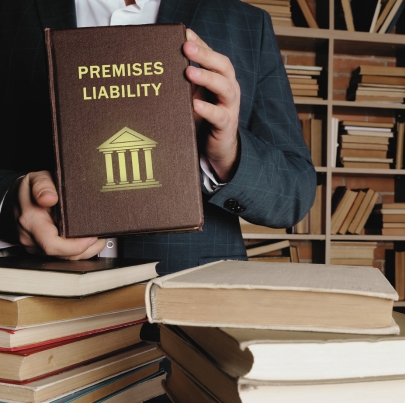Under the attractive nuisance doctrine, an occupier or property owner is liable for any harm a child sustains if a dangerous condition or area in the property attracts the child’s curiosity. An attractive nuisance is an unsafe condition or object that can attract kids to your property. Playground equipment, trampolines, and swimming pools are some examples of an attractive nuisance.

While Illinois does not follow the attractive nuisance doctrine, it requires property owners to ensure their properties are hazard-free. You have the right to seek compensation if your child gets injured on a property due to the property owner’s negligence.
What Is the Doctrine of Attractive Nuisance?
If your child sustains an injury on someone else’s property in Chicago, Illinois, due to hazardous conditions, you might ask: What is an attractive nuisance? An attractive nuisance is a hazardous object or condition on a property. The nuisance must have the potential to attract kids and cause harm or injury to them to qualify for this definition.
Attractive nuisances are usually the cause of costly injuries. The property owner or occupier is often legally responsible for injuries caused by harmful conditions within the property.
The attractive nuisance doctrine is a tort law that protects children against risks or dangers they do not know. It shifts the blame for injuries onto property owners when the victim (child) was trespassing.
Kids are naturally playful and curious. They may be attracted to some items on someone else’s property, even if they have a potential for harm or injury.
Children love exploring the world by touch, sight, and smell. The attractive nuisance doctrine considers this primal need for exploration when holding property owners accountable for injuries sustained by minor trespassers.
The attractive nuisance doctrine does not cover adults. The rule assumes that adults can differentiate between safe and unsafe conditions when trespassing on a property. The doctrine only applies if the adult sustains an injury when rescuing the child from the hazardous condition or object.
Why Are Children Considered Trespassers Under the Doctrine?
The attractive nuisance doctrine defines a trespasser as someone who unlawfully enters or steps into someone else’s property. Unlawful entry means that the individual did not have approval or permission from the property owner.
Under the attractive nuisance doctrine, the trespasser in question is a child. The doctrine states that the property owner or occupier owes trespassers the duty of care. It does not, however, require the property owner to help the trespasser become aware of the dangers.
If your child steps into someone else’s property without invitation, the child is deemed a trespasser. The law will not treat the child as an adult trespasser, as it gives the child special care.
The attractive nuisance doctrine considers children trespassers due to their lack of impulse control. It takes them some time to hit this developmental milestone. The doctrine also does not impose age limits on child trespassers. Courts only examine the case based on the child’s understanding of hazardous conditions or objects.
Requirements for the Attractive Nuisance Doctrine
The attractive nuisance doctrine only applies under specific circumstances. It imposes liability on property owners or occupiers if the following conditions are true:
- The attractive nuisance had the potential to harm the child
- The property owner had adequate reason to believe or know that the property may attract child trespassers
- Trespassing children were unfamiliar with the possible risks linked to their actions
- The property owner/occupier did not take appropriate steps to limit access or entry to the attraction
When hearing the case, the court will examine the total costs the property owner would have incurred to protect trespassers on the land or property. It will also compare the costs of fixing or maintaining the attractive nuisances against the potential dangers or risks they pose to children. The court will award damages based on this evaluation.
It is important to note that Illinois does not impose strict liability in the event of an injury or damages caused by an attractive nuisance. Instead, it holds property owners accountable for any injuries caused due to negligence. A lawyer may help compile sufficient evidence and prepare compelling arguments to prove the property owner’s negligence.
Examples of the Most Common Attractive Nuisances
Attractive nuisances take different forms depending on the environment. They can include playground equipment, swimming pools, abandoned vehicles, construction sites, landscaping features, and unattended machinery, as discussed below:
Playground Equipment
Poorly maintained and unsafe playgrounds can cause injuries to children. They also qualify as attractive nuisances if the children access them without the owner’s permission.
Playgrounds with old ladders, a trampoline with a worn-out net, or swings placed close together pose significant safety risks. The same applies to those with broken or rusted equipment.
Children are likely to sustain injuries from playgrounds due to falls. While most of these injuries are minor (resulting in bruises or scratches), they can cause fractures. The child may also suffer head or spinal injuries if the accident is serious.
Property owners must install the right equipment to ensure playgrounds are safe for all children. They should also have surveillance devices installed or security guards around the property. There should be adequate locking mechanisms to prevent trespassers from accessing the playground if it is closed to children.
Swimming Pools
Swimming pools qualify as attractive nuisances, as they pose drowning hazards to children. The attractive nuisance doctrine may apply to this case if a trespasser (child) sustains injuries due to a slip and fall or tripping hazard in a children’s pool.
Swimming pools that lack adequate safety features for kids can be subject to a premises liability lawsuit. An owner may also face a lawsuit if the owner fails to deploy enough staff on-site to protect children.
The law may hold the property owner liable for the child’s injuries if some of the swimming pools’ features intrigue or attract kids. It may also apply if children are likely to enter the swimming pool without permission or if the owner knows the pool’s potential dangers.
Unattended Machinery and Abandoned Vehicles
Children might find unattended machinery and abandoned vehicles intriguing, as they lack impulse control. They may sustain injuries, such as bruises or cuts, due to rusted or broken parts from the tools and vehicles.
Examples of machinery that pose injury risks to children include plumbing tools, power tools, old gasoline pumps, and lawnmowers. Farm tools like plowing machinery and tractors can also be attractive nuisances.
An abandoned vehicle is one with no number plates or irreparable damages. The term also refers to vehicles that have been inactive for the past two months or have expired or canceled registration. Examples of unsafe abandoned vehicles include motorcycles, cars, caravans, trailers, and trucks. Therefore, the answer to the question, “Can you sue if you slip and fall in a parking lot?” may be yes, if there were potential nuisance hazards.
Construction Sites
Ongoing construction sites can attract curious children and expose them to injury. They can have attractive nuisances, such as unstable surfaces, artificial ditches, heavy equipment, and gravel or sand.
Children may climb onto unattended scaffolding or ladders on construction sites and suffer injuries. They may also fall into open pits when trespassing on the site.
The attractive nuisance doctrine requires construction project managers to have adequate measures to prevent children from stepping into their construction sites. They must build guard rails around unsafe surfaces or ditches to protect workers on site. Other preventative measures include installing surveillance equipment and having security guards on site.
Landscaping Features
While landscaping features improve a property’s aesthetic appeal, they can injure children who find them intriguing. These features may include treehouses, ponds, and fountains. Poisonous or thorny garden plants and sharp tools are also examples of attractive nuisances.
Under the attractive nuisance doctrine, landowners or occupiers should have appropriate measures to prevent children from trespassing on their properties. Further, they should not leave sharp tools lying around their properties.
They should keep pesticides out of children’s reach. The same applies to fertilizers and cleaning supplies, which have a potential for intoxication when consumed by kids.
How To Prevent Attractive Nuisances on a Property
Since the attractive nuisance doctrine gives children special protection against harmful objects or conditions, property owners must ensure their properties are free of such hazards. Tips that owners should follow to ensure attractive nuisance accidents don’t happen on their properties include:
Keep The Property Maintained
Every object or landscape condition can attract curious children. Therefore, property owners should take precautions to help lower their liability. For starters, this may include ensuring that the land is inaccessible to trespassers. Install a fence that will keep out children.
They should consider inspecting the property for any hazardous conditions or objects. If they rent the property, ensure the property owner or manager carries out routine maintenance to reduce the risk of accidents or injuries.
Fix any broken playground features. If in a rental property, people should ask the property owner or manager to uninstall new features if the existing ones are no longer useful.
Trimming the bushes and branches can help reduce the nuisances. Property owners or operators should also declutter the compound and thoroughly clean slippery surfaces, including but not limited to patios, walkways, and swimming pool decks. If people own/run a business with a parking lot, they should keep it free from slip and fall hazards to prevent getting sued.
Property owners or operators with swimming pools on site should refrain from leaving it unsupervised. Keep the entry doors closed when the pool is not in use. Property owners should also have a pool cover to prevent drowning hazards.
Give a Warning
Giving warnings can help avoid a premises liability lawsuit if a trespassing child sustains injuries on a property. Instead of posting signs on the land, property owners ought to inform parents about the potentially attractive nuisances. They should ask the parent to be responsible for his or her child’s actions when the child trespasses on your property.
Warnings may help prevent trespassers if the property is too large to be fenced. In the event your child is injured, and you bring a lawsuit, the property owner could reference the warnings in court, which might affect your recovery.
Involve your lawyer if you are unsure about such warnings, whether one was issued, and if your child still has a claim for compensation.
Refer to Your Local and State Laws
Local and state laws are a great resource to learn more about the rights and responsibilities of a property owner. There are state laws that protect different types of properties. These laws cover the benefits of holding or owning property.
As a landowner, the law gives a person the right to use, occupy, enjoy, or transfer the land. Landowners also have the right to exclude other people from accessing or using it without their approval.
The right to be free of private or public nuisances is crucial in attractive nuisance-involved cases. It allows landowners to seek or prevent redress for any actions that interfere with the enjoyment and use of their property. These activities may include noise caused by trespassers, hazards, or obstructions, limiting access to the property.
Property owners can also contact their homeowner’s insurance provider for guidance on attractive nuisances, such as pools and playgrounds. They may benefit from asking the steps they can take to keep these features safe and secure for children.
A premises liability lawyer can guide you through child trespassing laws and property rights. Legal council may aid you in understanding how the state’s laws apply to your child’s case, and whether you may pursue compensation for his or her damages.
Increase Personal Liability Coverage
If their current personal liability coverage is not enough to cover injury claims that might result from the attractive nuisances on their properties, landowners may consider increasing the coverage limit. They can do this by buying an umbrella insurance policy from their insurer.
Personal liability insurance provides protection against the financial consequences of causing injuries or damages to others. It can extend to household members, depending on the insurance provider.
The standard personal liability coverage offered by most insurers is inadequate to cover accidental deaths or serious injuries on someone’s property. As such, property owners may have to upgrade slightly to a higher package for maximum protection. As property owners increase liability coverage, they ought to ensure they have all the appropriate precautions to prevent attractive nuisances on their land or properties.
Renters should speak to the property owner about his or her personal liability coverage limits. If uncomfortable with the answers, renters should ask the property owner to upgrade to a different coverage package or relocate to another property whose owner has adequate coverage. Renter’s insurance policies cannot cover liability for attractive nuisances. They only cover damages or injuries the policyholder sustains after a theft scenario or natural disaster. The attractive nuisance doctrine imposes liability on property owners instead of tenants.
Steps to Follow if Your Child Sustains an Injury Due to an Attractive Nuisance
Under Illinois premises liability law, property owners or occupiers are generally not liable for injuries sustained by trespassers due to an unsafe condition or activity on the land. Although Illinois does not recognize strict liability under the doctrine of attractive nuisance, many municipalities in the state have laws that strictly define the duties owed by property owners to children. As such, you may be able to bring a negligence claim against a landowner or occupier if your trespassing child gets injured on his or her property. Additionally, the law advises property owners to ensure that their premises are free of unsafe conditions, and to warn child trespassers of dangers that exist.
You can also bring a premises liability claim against the property owner if your child has a legal right to enter the property. In such a situation, the property owner or occupier has a duty to ensure guests or invitees do not suffer injuries on the property.
Various parties can be liable in a premises liability case. These parties include government property operators, leaseholders, property owners, business owners, and owners of private residencies. If the responsible party is a leaseholder, evaluate the leasehold contract for clauses on who is responsible for property maintenance.
Illinois premises liability law allows you to seek economic and non-economic damages if your child gets injured on someone else’s property when the child was lawfully on the property. These damages include medical expenses, physical pain and suffering, loss of enjoyment of life, and punitive damages if the property owner or occupier was grossly negligent.






